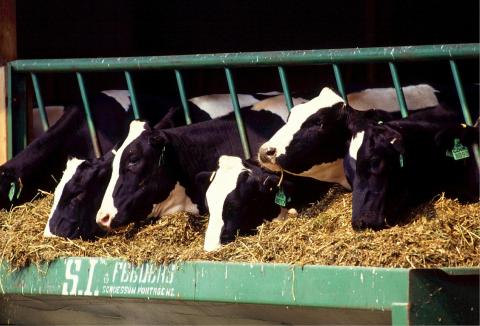Using Milk Urea Nitrogen to Calculate Urine and Urinary Nitrogen Output

Using Milk Urea Nitrogen to Calculate Urine and Urinary Nitrogen Output
1) Why is this important?
The amount of urine produced by dairy cows affects total manure excretion because urine excretion accounts for about 1/3 of the total manure excretion on a weight basis (NRC, 2001). With the development of manure storage facilities knowing how much urine will be produced and how large a storage facility will be needed.
2) Development of the equation.
Researchers at several institutions evaluated models to predict urine output (Nennich et al., 2006). Early equations linked urine output to the intakes of sodium and potassium along with nitrogen (crude protein of the diet). Urinary excretion is due to regulation of the body’s sodium and potassium balance. A challenge for using these equations was that the intake of these components was required. While it is possible to know how much of each is fed, it is more difficult to know how much is consumed without measuring the content of the feed refusals. In the late 1990’s and early 2000’s several equations were developed including using body weight, crude protein intake, and dry matter intake along with dietary cation anion difference. Dairy producers have access to MUN and can accurately calculate both urinary excretion and urinary nitrogen excretion on a per cow basis and then convert it to a pen or herd basis.
3) Implementation of the equation
We can estimate urine excretion with the following formula:
Based on the equation reported by Nennich et al. (2006) urine excretion in kg/day can be estimated using the following equation = (MUN × 0.563) + 17.1
For instance- let’s say your MUN was 10 mg/dL (considered normal)
Urine excretion = 10 × 0.563 + 17.1 = 22.7 kg/day, 1 kg =1 liter
22.7 liters is about 50 pounds of urine (1 liter = 2.205 pounds). For a herd of 200 lactating cows this equals 10,000 pounds of urine per day. To convert to gallons (1 gal = 8.35 pounds) or about 1,200 gallons/day.
What happens if your MUN is 16 mg/dL (considered high)?
Urine excretion = (16 × 0.563) +17.1 = 26.1 kg (liters) per cow per day.
This is equivalent to 5,220 liters (or 1378 gallons) per day for our herd of 200 cows. This results in 178 extra gallons of urine per day.
4) How much nitrogen will these cows excrete in their urine per day?
University of Maryland researchers (Kohn et al. 2002) developed an equation which estimates the amount of nitrogen excreted in urine by a cow each day. In this equation urinary N excretion in grams per day = (15.1 × MUN) + 27.8. For example, using the example above with 10 mg/dL MUN urinary N excretion will equal:
15.1 × 10 =151 + 27.8 =178.8 g/day.
With 454 g/pound that amounts to 0.394 pounds of N per cow per day. For a 200 cow dairy this will translate to almost 79 pounds of N per day.
What if the MUN = 16 mg/dL.
(15.1 × 16) + 27.8 = 269.4 g/day or 0.593 pounds of N per day. For a 200 cow dairy this translates to 118.7 pounds of N
5) What about other breeds?
The above equation is for Holsteins, but what if you have a different breed? You can still estimate urinary nitrogen if you know the body weight. This equation will work for all breeds including Holsteins (Kauffman and St. Pierre, 2001).
Urinary nitrogen (grams/d) = 0.0259 × Body weight in kilograms × MUN.
To convert from pounds to kg = pounds /2.205 = kg. For instance, a 1000 pound cow weighs 454 kg and using a MUN of 16 mg/dL
Urinary Nitrogen = 0.0259 × 454 × 16 = 187.9 g/day of N
Conclusion
These equations can help dairy producers calculate the size of storage facilities needed and determine the amount of nitrogen produced.
References
Kauffman, A.J. and N.R. St. Pierre. 2001. The relationship of milk urea nitrogen to urine nitrogen excretion in Holstein and Jersey cows. J. Dairy Sci. 84:2284-2294.
Kohn, R.A., K.F. Kalscheur, and E. Russek-Cohen. 2002. Evaluation of models to estimate urinary nitrogen and expected milk urea nitrogen. J. Dairy Sci. 85:227-233.
Nennich et al., 2006. Prediction and evaluation of urine and urinary nitrogen and mineral excretion from dairy cattle. J. Dairy Sci. 89:353-364.
NRC. 2001. Nutrient Requirements of Dairy Cattle. 7th Rev. Ed. Natl. Acad. Sci. Washington, DC.
